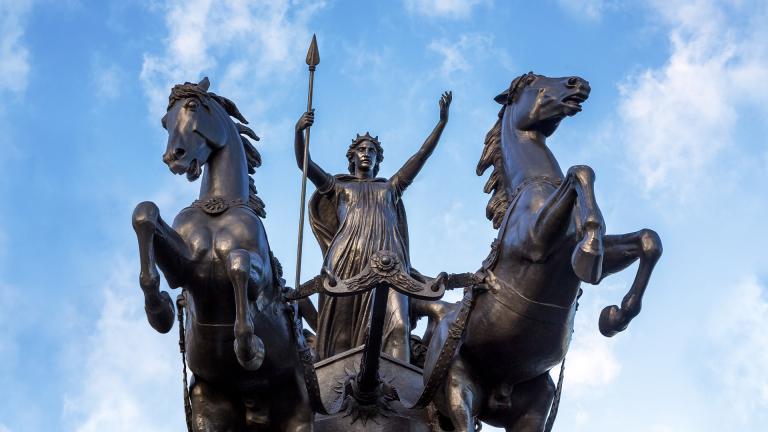
Read more about Ancient History

Boudica is one of British history’s most iconic female figures. Much of what we know (or at least think we know) about her comes from just two sources: the Roman historians Tacitus and Cassius Dio.
Historical accounts paint a heroic (if also somewhat barbaric) picture of her life and exploits. She was reportedly queen of a British tribe in the first century AD, during the Roman occupation of Britain.
However, after the Romans started increasingly infringing upon British natives’ rights, Boudica led a military revolt against the imperial foe. This campaign culminated in the Battle of Watling Street — one of the conflicts featured in the Sky HISTORY series Britain’s Lost Battlefields.
Nonetheless, concrete details of Boudica’s story remain elusive. How exactly did the Romans provoke her ire? What were the major events of the uprising? How did it change the course of British history? Here’s what our own investigators here at Sky HISTORY know…
The Roman Empire formed its British province in 43 AD, eventually taking over most of what is now England and Wales. This conquest was initiated under the emperor Claudius, who struck deals with British tribal leaders to secure their support for his regime.
These signatories included Boudica’s husband Prasutagus, king of the Iceni tribe. Prasutagus crafted his will in a way that he hoped would keep the Iceni in the Romans’ good books. The document decreed that, upon Prasutagus’s death, his lands would be inherited by his two daughters and the Roman emperor.
By the time Prasutagus did pass away in 60 or 61 AD, Claudius had also died. In 54 AD, the Roman imperial throne passed to his grandnephew Nero, who apparently didn’t have the most conciliatory attitude towards the Iceni.
When the Romans heard that Prasutagus had died, they chose to ignore the contents of his will. The imperial authorities had spotted too good an opportunity to capture the Iceni kingdom outright.
According to Dio, the Romans opted to recall loans they had previously lent to the Britons. In one shocking account by Tacitus, the Romans went as far as seizing the late king’s assets, flogging Boudica and raping her two daughters.
In one recorded speech attributed to Boudica, she implies that the Romans placed onerous taxes on herself and her countrypeople. She even insists that being officially enslaved would be preferable to ‘possessing empty titles of freedom, to have to ransom ourselves every year!’
Boudica’s plight was no longer that of the Iceni alone. She learned that neighbouring Celtic tribes had been similarly mistreated by their Roman overlords. Fuelled by their shared grievances, these tribes formed an anti-Roman coalition with Boudica at its head.
The rebels went on to incinerate three major cities of Roman Britain in relatively quick succession: Camulodunum, Londinium and Verulamium. (These correspond to modern-day Colchester, London and St Albans respectively.)
These attacks evidently took the Romans by surprise, as they were woefully unprepared to contain the threat. Boudica’s army defeated an entire legion at Camulodunum, while only 200 ill-equipped auxiliaries were left to attempt to defend Londinium.
After their long run of military success against the Romans, Team Boudica must have been brimming with confidence. However, the tide was finally turning in the Romans’ favour. They dispatched one of their top generals, Gaius Suetonius Paulinus, to deal with Boudica.
Their respective armies eventually met in the general area of Watling Street (the battlefield’s exact location remains unclear to this day). Suetonius’s tactical masterstroke was to wait in a narrow pass with woodland to his army’s rear. This forced the arriving Boudican soldiers to attack the Romans head-on, a recipe for disaster.
The Britons who kept trying and failing to penetrate the Romans’ shields left themselves dangerously exposed to the Romans’ swords. The result was a bloodbath, with women and animals also killed.
Boudica’s fate after the crushing defeat of her army is unclear. Tacitus claims that she poisoned herself, while Dio states that she died of illness.
Though Nero had considered permanently withdrawing his forces from Britain, the rebellion’s failure left the Roman occupation secure for centuries. In the event, the Romans did not leave the island until 410 AD.
Has Boudica’s story captured your imagination? You can learn a lot more about the Roman era, and other inspirational female leaders of the past, by subscribing to the Sky HISTORY Newsletter.